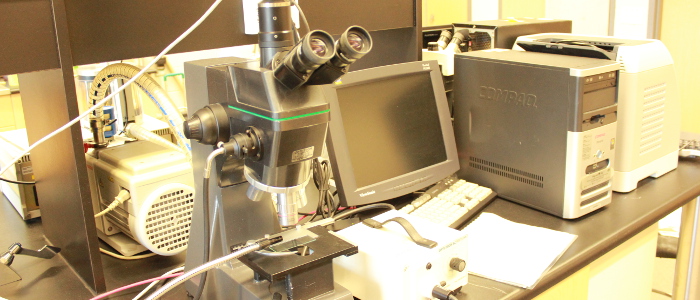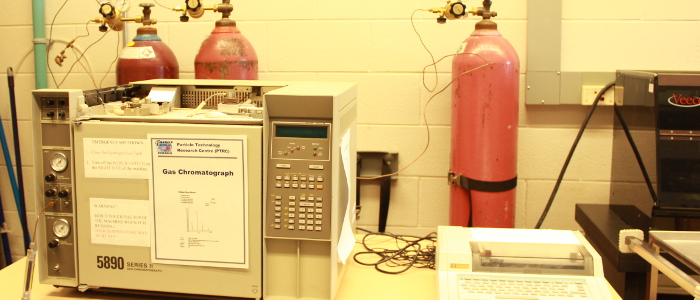





Particle Research Facility is equipped with a variety of analytical instruments. Our knowledgeable staff and researcher provide consistent, accurate and comprehensive analytical services in a friendly environment and at affordable rates.

Scanning Electron Microscopy (SEM) is a powerful imaging instrument capable of analyzing particles, textures, surface features, and structures, too small to be seen with an optical microscope. The Hitachi Variable-Pressure Scanning Electron Microscope (VP-SEM) incorporates state-of-the-art technology to produce high quality SEM imaging. Equipped with a powerful Back-Scatter Electron (BSE), and Energy-Dispersive X-ray (EDX) detectors the VP-SEM at PRF is an ideal analytical tool for many research applications. When non-conductive materials such as biological samples or pharmaceuticals are analyzed with SEM, the electron beam irradiation causes charge build-up, and thus poor image quality. The variable-pressure mode employs a gaseous environment around the sample to reduce the charge build-up and dramatically improves imaging quality. The VP-SEM is ideal for many biological, pharmaceutical, polymer, and food sample analysis where charge build-up can be severe and other methods such as gold-sputtering are not desirable, or in-effective.
Please contact us for more information on Scanning Electron Microscope. For information on standard Charges please click here.

The Mitutoyo FS70 high-resolution optical microscope is equipped with infinity corrected optical lens, ACE I fiber-optic light source, Leica DC300 digital camera, and Vision Gauge software.
The Zeiss Axioskop40 optical microscope has a digital camera and a Linkam temperature control system optimized for sample analysis, and easy sample access. The system includes the highly stable LTS350 heating/freezing stage.
Please contact us for more information on Hi Resolution Optical Microscope. For information on standard Charges please click here.

The Dektak 8 surface profiler combines high repeatability, low-force sensor technology, and advanced 3D data analysis for surface characterization of MEMS, semiconductors and other thin/thick films. The system uses a programmable diamond tip stylus to characterize surface roughness, waviness and step height, as well as 3D mapping of surfaces.
Please contact us for more information on Stylus Surface Profiler. For information on standard Charges please click here.
The Rhopoint Triple Angle(20/60/85°) glossmeter is a simple to operate instrument for measuring the gloss of flat surfaces. Using all three geometries described in ISO 2813 and ASTM D523 the instrument gives the best possible measurement resolution for all surfaces from matt to high-gloss coatings.
Please contact us for more information on Novo-Gloss Glossmeter. For information on standard Charges please click here.

X-Ray Diffraction (XRD) is most commonly used as an identification tool. The Rigaku MiniFlex XRD is a compact system that can be transported from the laboratory to the field. This instrument features high precision and is ideal for quantitative analysis of: asbestos and free silica; cristobalite contained in concrete, determination of the phase composition of unknown crystalline and amorphous materials; determination of percent crystallinity in a polymer; and quality control of pharmaceuticals. Features and Benefits:
Please contact us for more information on PRF's Rigaku MiniFlex XRD Services. For information on standard Charges please click here.

Please contact us for more information on PRF's Particle Size Measurement Services. For information on standard Charges please click here.
At Particle Research Facility we employ the GA-8 Gilsonic UltraSiever to perform sieve analysis. The GA-8 is designed to use up to seven 8" diameter full-height test sieves. With this equipment fast and accurate sonic sieving to 5µm can be achieved. Features and Benefits:
Please contact us for more information on Sieve Analysis Services. For information on standard Charges please click here.
The Hosokawa Powder Characteristics Tester is a single instrument which provides seven mechanical measurements and three supporting measurements of dry bulk powders. It complies with Standard Test Method ASTM D6393-99, as well as JIS and ISO standards. The powder tester was developed to improve handling, efficiency, and accuracy in testing the bulk properties of dry powders. It features a microcomputer, electronic balance, a data printer, and a built-in dust collection system. It is an integral tool in characterizing the flow behavior (flow ability) and the flood behavior (flood ability) of bulk materials by measuring the following:
Please contact us for more information on Powder Characteristics Testers. For information on standard charges please click here.
The term BET was derived from the first initials of Burnauer, Emmett and Teller, and refers to the method of measuring the surface area and porosity of solid materials using the principals of physical adsorption and de-sorption of gas.
The Micrometric's ASAP 2010 system has the versatility to characterize samples using a number of different adsorptive gases such as: Nitrogen, krypton, oxygen, carbon dioxide, carbon monoxide, and butane. The system performs automatic single-point and multi-point BET surface area measurements, as well as Langmuir surface area, Olivier-Conklin DFT (tm) analyses, full adsorption and de-sorption isotherms, pore size distributions, and pore volume distributions.
The ASAP 2010 data acquisition system allows resolution of pores separated by only a fraction of an angstrom. The micro-pore system combines various techniques in one static-volumetric instrument such as: Harword-Kawazoe, Dubinin (both Astokhov and Radushkevich models), MP-Method, t-plot method, and Saito-Foley method. Sample tubes used in the system are available for various size pellets, cores and powders and pressure measurement range varies from 0 to 950 mmHg.
Please contact us for more information on BET porosity or surface area analyses available at PRF. For information on standard Charges please click here.

High Performance Liquid Chromatography is a common analytical tool used in a variety of applications such as identification, separation, purification and quantification of various compounds. In our facilities there are two different HPLC systems:
This system is equipped with ProStar 330 Photodiode Array (PDA) detector with prism technology that improves light efficiency and spectral imaging, producing high-resolution spectra. The system is also equipped with ProStar 230 Ternary Solvent Delivery Module and ProStar 410 Auto Sampler.
Features and Benefits:
Our Waters Breeze HPLC system comes with Waters 2414 Differential Refractive Index (dRI) , and Waters 2487 Dual Absorbance detector both of which are unsurpassed in sensitivity, stability and reproducibility. It is also equipped with Waters 1525 Binary HPLC Pump, and Waters 717 plus Autosampler. With unsurpassed sensitivity, stability and reproducibility the Waters Breeze HPLC System provides a total sample analysis solution for many applications including sugar analysis, polymer analysis, preparative analysis and quality control applications.
Features and Benefits:
Please contact us for more information and quotes on Chemical and Bio-chemical Analysis. For information on standard Charges please click here.

Gas Chromatography/Mass Spectroscopy is used to separate chemical mixtures (the GC component), and to accurately identify compounds using very sensitive detectors (the MS component).
The Saturn 2200 GC/MS comprises of the CP-3800 GC , the 2000 Series Ion Trap MS and both a TCD detector and a FID detector. These components create a platform for the world's most versatile GC and flexible MS. Under Saturn Workstation control, complex configurations become very simple to operate.
Features and Benefits:
Please contact us for more information and quotes on PRF's GC/MS Services.
Thermogravimetric Analysis (TGA) is a technique for measuring changes in mass as function of temperature primarily used to determine the composition of substances. It is also used to analyze adsorption and desorption, reactions with purge gases, and ash content. From TGA curves, data on the kinetics and thermodynamics of the various chemical reactions, reaction mechanisms, reaction intermediates and final reaction products are obtained
The Mettler Toledo TGA/SDTA851e offers thermo balance with superior weighing performance, the broadest sample size range as well as accurate control of gas volume and temperature based on our proprietary SDTA technology.
Features and Benefits:
Please contact us for more information on Thermal Analysis. For information on standard Charges please click here.
Differential Scanning Calorimetry (DSC) is a thermal analysis technique used to measure the temperatures and heat flows associated with transitions in materials as a function of time and temperature. DSC data provide information about physical and chemical changes that involve endothermic and exothermic processes, or changes in heat capacity, and is commonly used in the plastics and adhesive industries, in safety technology, as well as in the chemical, pharmaceutical, food, electronics, and automotive industries.
The Mettler Toledo DSC822e has a unique sensor design resulting in an unsurpassed combination of performance features such as flat baselines, very high sensitivity and excellent peak resolution. The ceramic sensor makes it the most robust instrument on the market and an ideal tool for measurements of thermal effects in R&D and QC environments.
Features and Benefits:
Please contact us for more information Differential Scanning Calorimetry. For information on standard Charges please click here.
Fourier Transform Infrared (FTIR) spectroscopy is a powerful analytical tool for characterizing and identifying organic molecules. Using the IR spectrum, chemical bonds and the molecular structure of organic compounds can be identified.
A molecule that is exposed to infrared rays absorbs infrared energy at frequencies which are characteristic to that molecule. During FTIR analysis, a spot on the specimen is subjected to a modulated IR beam. The specimen's transmittance and reflectance of the infrared rays at different frequencies is translated into an IR absorption plot consisting of reverse peaks. The resulting FTIR spectral pattern is then analyzed and matched with known signatures of identified materials in the FTIR library.
Please contact us for more information Fourier Transform Infrared (FTIR) spectroscopy. For information on standard Charges please click here.
UV-VIS Spectrophotometry is used to determine the identity of a compound based on absorption or transmission of UV/VIS light . It can also be used to measure concentrations of absorbing materials based on developed calibration curves of the material. It is used extensively in the Pharmaceutical, Biotech, Environmental Testing, and Agricultural industries.
The Agilent 8453 spectrophotometer comes equipped with all the diode-array advantages. It scans fast, has excellent sensitivity, virtually absolute wavelength reproducibility, exceptional ruggedness and reliability. It also has better than 2nm resolution, wavelength range of 190 to 1100 nm and less than 0.03 % stray light is standard.
The Cary 100Bio spectrophotometer is equipped with variable slits that allow optimum control over data resolution down to an impressive 0.2 nm resolution. It also has a phase locked wavelength drive to prevent peak shifts and peak suppression at high scanning speeds, and the Cary Bio package with modules for all of your life science.
Please contact us for more information on PRF's UV-Visible Spectrophotometry Services. For information on standard Charges please click here.
The manufacturing industry in North America is a technology driven sector that is fast paced and highly competitive. In many circumstances it is the ability of manufacturer to develop new products and improve on existing products in a fast, cost effective, and efficient manner that ultimately gives them the competitive edge. The Q-Sun Xenon Test Chamber provides fast, reliable weathering durability data. Xenon arc testing is the best available simulation of full-spectrum sunlight available because it includes ultra-violet, visible and infrared light.
Q-Sun uses full spectrum xenon arc lamps to reproduce the damaging wavelengths of light encountered either indoors or outdoors. Features such as water spray, relative humidity control and chiller significantly expand the range of environmental conditions that you can simulate. The Q-Sun features a flat specimen mounting system that easily accommodates three dimensional products giving users maximum flexibility.
For more information on Weathering Service with the Q-Sun Xenon Test Chamber please contact us at PRF. For information on standard Charges please click here.